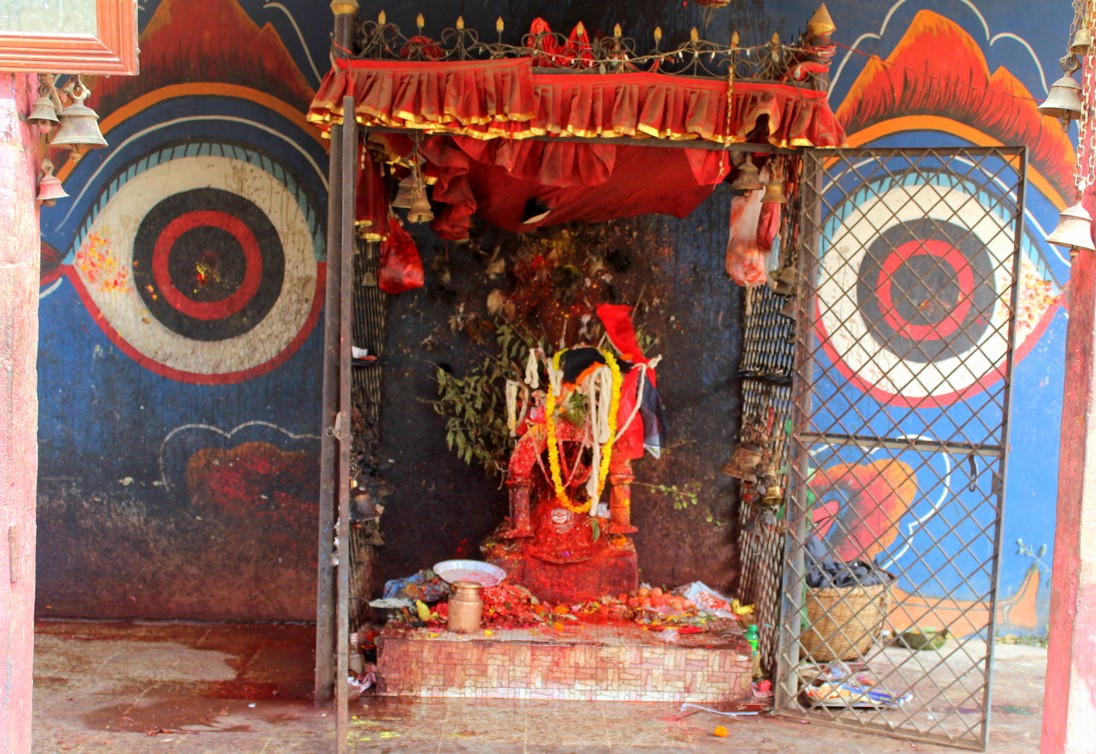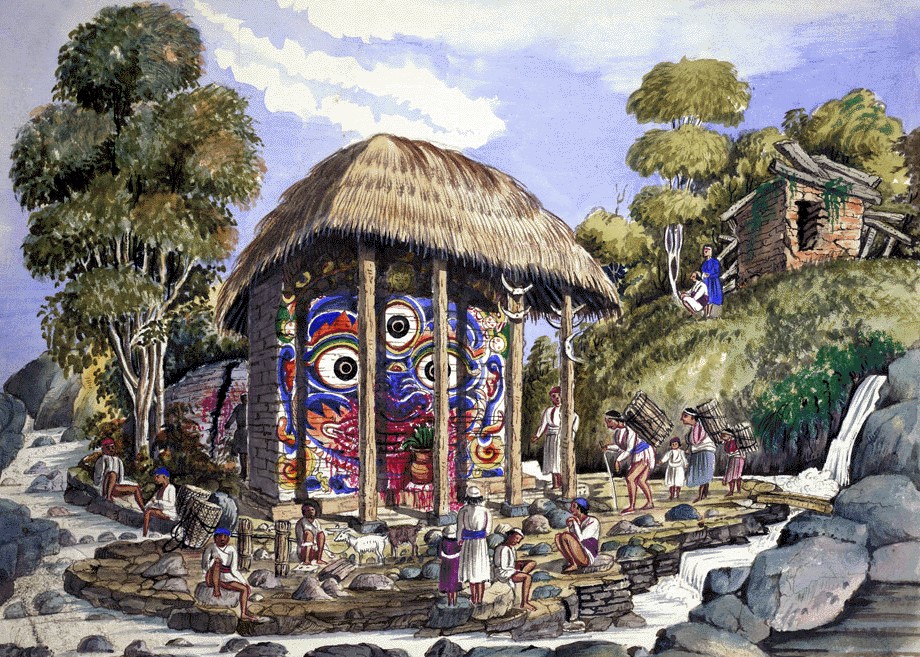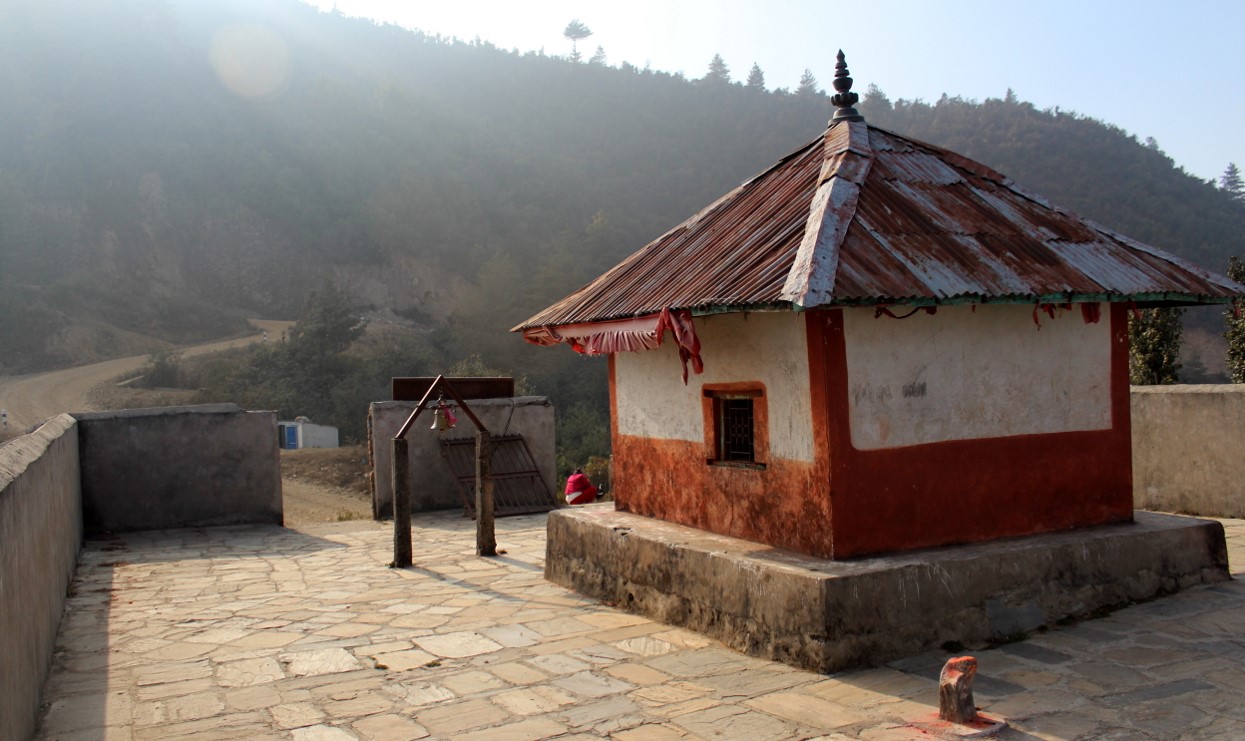We reached the Manakamana Temple at Dalchowki early in the evening. As the sun peaked high above us and gently dissolved behind the green hills and wide-open landscapes, we were in a state of dilemma whether to seek shelter or hitchhike our way back, because the locals had told us there wouldn't be any transport until the next day. To add to the woes, there was no cell phone coverage either. We reached Dalchowki later than we thought, because we took the path that we thought was another trail. "Stay the night," said the priest, who had the only house in the hill that was greatly affected by the earthquake. We looked around the surrounding area to see if there were any houses where we could stay the night. But, the only thing we could see apart from Manakamana Temple was the home of the priest which was leaning like the tower of Pisa, hanging on the cliff, which wasn't any tempting either.
Our trip had started at the heavily-crowded Lagankhel buspark. Amidst the urban connectivity and chaos of the Kathmandu valley, the bus park although not managed well, is still convenient, because you will literally find buses to go anywhere in Lalitpur. The bus park is a very colorful place, and people from all walks of life roam around it. Many are tourists passing through to Patan Durbar Square, whilet others include students and local travelers. It is also a vital place for livelihood for snack sellers, who make their living by selling street foods, water, chips, and peanuts. I was there waiting for my travel companion for the day, a college friend whom I hadn't met for three long years. Together, we had traveled to many remote and rugged trails within the valley that not many people were aware of. After buying some snacks and mineral water, we boarded a bus to Tika Bhairav. The plan was to reach Tika Bhairav, and then to Manakamana Temple in Dalchowki.
Away from the city, there are many places that are too often overlooked or forgotten but have plenty to offer. The neglected landscapes in Lalitpur are a dream for anyone looking for solitude and escape. I had been to Lele a few times, but hadn't visited Tika Bhairav, one of the many popular Bhairav temples in the valley. Famous British painter Henry Ambrose Oldfield, who had painted many popular monuments in the valley in the 1850s, including the durbar squares in Patan, Kathamndu, and Bhaktapur, and Pashupatinath Temple, had also painted the temple in Tika Bhairav in 1857. Oldfield described the Bhairav shrine at the time as 'Head of 'Teekha Bhairab' near Pherphing. This painting is a colorful depiction of the Bhairav shrine, an open-air image under a sheltering roof.
Traveling on a local bus can be challenging, with people standing everywhere due to lack of seats. You know the bus will not move until it is full, and it is very difficult to get a seat. But, it is the small moments we saw that made our journey special; like a woman volunteering to hold a young student's bag despite being surrounded by grocery bags herself, a mother trying to comb her daughter's hair, who was more interested in the cotton candy a child next to her was eating and the old man who was looking at a young man with a glint in his eye, hoping he could get a seat. The slow yet eventful hour-long bus ride came to an end. Little did we know that it would be the last comfortable ride we would be taking that day.
The bus stopped very close to the temple, on the bank of the Nakhu River. The place looked nothing like the painting. The open air image of the 1800s had been replaced by a concrete temple. The river had reduced in size and lost its old glory because of pollution, but the temple was still revered by the people. People from far-flung villages came to visit the fearsome form of Lord Shiva. Close to it was a rock formation also worshipped by the people. "Don't forget to pray to Shiva and Parvati," said one of the children playing around with the goats. Even the goats stood on two feet like Tumnus from Narnia to get some prasad (offerings made by the devotees) from the temple.
Our next destination was the Manakamana Temple at Dalchowki. There have been several legends regarding how Dalchowki got its name. According to the locals, Dalchowki was one of the three goddesses, along with Phulchowki and Sanchowki who protected the valley, and a temple was built dedicated to Dalchowki Devi. Although a bus to Dalchowki was available as per the pilgrims we met, after waiting half-an-hour for the bus, we decided to hike our way. Our journey started on a recently pitched road, but it soon changed into a dramatic terrain after we passed through a stone mining area leading to a bumpy road.
We saw some trucks on the way and decided to hitchhike our way to the destination. We got on back of a pickup truck and went on a rough ride. There were no roads on this section and the terrain was too rugged, and we saw very few people. We were disconnected from the rest of the world, and reconnecting to the land and ourselves. But we were so enchanted by the dangers and charm of our journey that we did not realize when we got off the grid, and in the worst possible way. By the time we realized it, we were already close to Bhattedanda. It’s very important for travelers to know when to keep moving and when to stop. If you think you might have gone off-trail, you need to stop and reanalyze. Although you might be tempted to keep going a little further, you might often get even more lost if you keep going.
"You can either go to Kavre or Hetauda from here," said the truck driver. We looked at each other with bemusement. I couldn't say much, since we were more at fault for not paying attention to the road than the driver for not stopping. We got off the truck and started talking to the locals to know if there was any way out. Luckily, a woman at the nearby tea shop told us there was still a way to reach Dalchowki. "It is not going to be easy, but keep following the path without changing directions," she said, pointing at a narrow path.


So, we continued walking through the rocky path, surrounded by green fields and hills covered with indigenous plants. We saw remote villages in the distance, unspoiled by modern concrete buildings. At times, there were the near-vertical scrambles, too, and we occasionally stopped to breathe in the moist air from pine and rhododendron trees, which renewed our energy with each step. We promptly lost ourselves in the vast beauty of the place. It wasn't easy, but we finally reached the remote cliff-side temple.
We were having an engaging conversation with the priest, when the temperature dropped drastically and we were surrounded by the mist. "Sometimes we even have snowfall here," said the priest. We knew spending the night there would be very difficult, so we were desperately looking for a way out. We tried to stay calm and think rationally. In the distance, we saw a group of people and thought of approaching them to see if we could get any help. As we moved closer, we saw a school bus beside them, and our happiness knew no bound. They were a group of people who had come for a picnic. It was a reunion of the 1997 SLC batch of a school in Chapagaun. They were kind enough to invite us for a buffet. There we were, somewhere in the middle of nowhere, without knowing how we were going back, but enjoying some delicious kebab and pulao on top of an isolated hill. We talked to the team leader, and he offered us a ride back till Chapagaun.
We got on the bus. Half of the picnickers were drunk by now. Inside the bus, it was getting chaotic like a rave party. We were going along the perilous road, and they had a sudden change of mind. "Let's go to PIA park," shouted one of them. And all of them agreed. We had to get off the bus and start another hike. It was getting darker by the minute. For a while, we stood on the side of the road hoping to stop a vehicle, but we weren't visible, and the drivers didn't slow down either. So, it was best we walked in the direction we came from, since nobody was stopping to pick us up. It was then that my experience of hitchhiking came into play. Since very few cars or reserved buses stopped during the evening, our best way out was on a pickup truck. Usually, it was the truck drivers who picked up hikers to have some conversation on an otherwise long and lonely trip. And so, after a while, there it was—a pickup truck that stopped for us. "Get in! I will drop you till Dhapakhel," he said. The colorful lights and the Bollywood music suggested we were in for a fun ride. Our memorable trip was finally coming to an end. Despite the area’s inaccessibility at times, Dalchowki is perfect for those wanting to explore the least trodden trails of Lalitpur.










